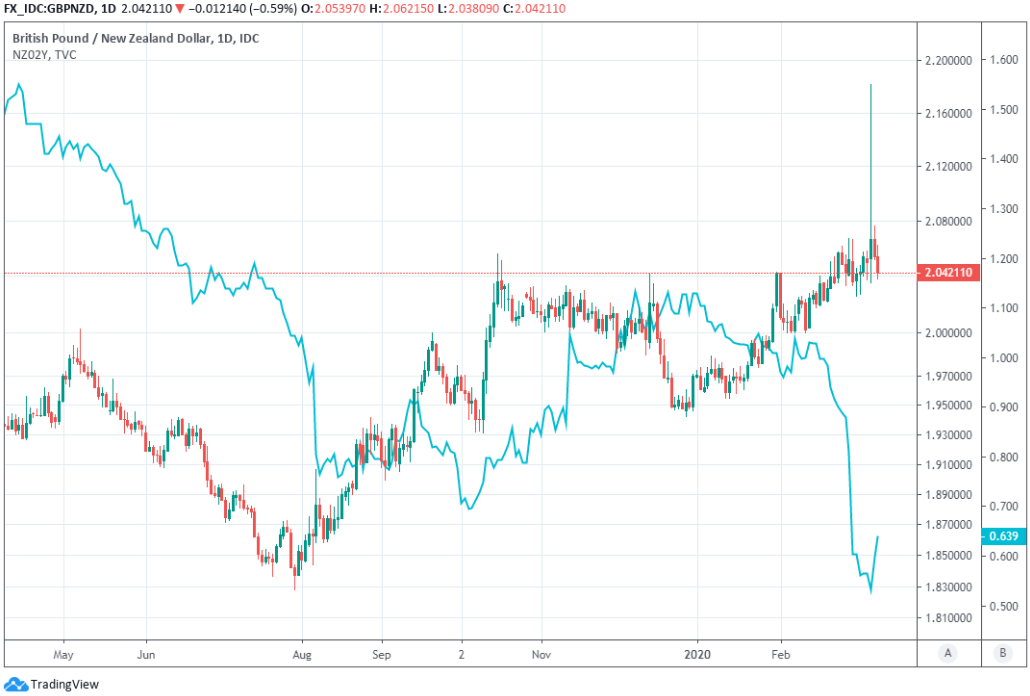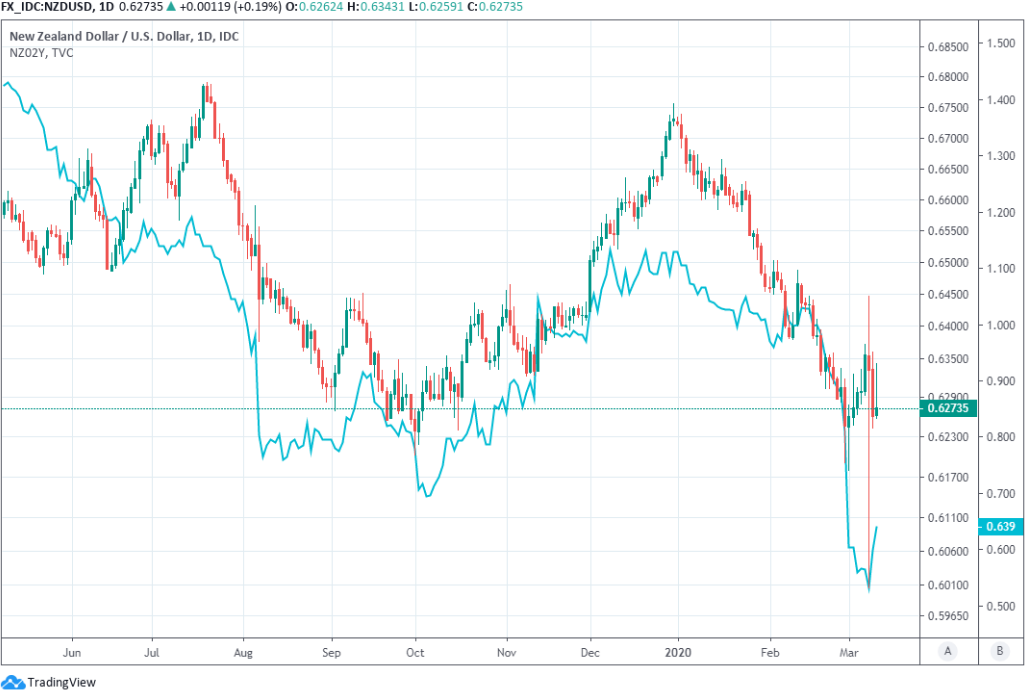New Zealand Dollar Rules Major Currency Roost as Other Risk Assets Crumble
- Written by: James Skinner
-
- NZD bests all major rivals despite dire day for risk assets.
- Stocks fall across globe as investors rush to safe-havens.
- Bonds and safe-haven currencies bid, as risky NZD rises.
- NZD rates offer highest 10Yr yield among major currencies.
- On RBNZ's steady hand and as Gov readies virus stimulus.
- But ASB says NZD gains and yield advantage won't last.

Image © Adobe Stock
- GBP/NZD Spot Rate: 2.0436, up -0.85% today
- Indicative bank rates for transfers: 1.9721-1.9864
- Indicative broker rates for transfers: 2.0129-2.0252 >> find out more about this rate.
The New Zealand Dollar ruled the major currency roost Wednesday even as other risk assets like stocks and commodities crumbled again amid another flight to the safety of the bond market, which may have benefited the Kiwi given that it now offers some of the highest yields among comparable economies.
New Zealand's Dollar rose broadly despite another day in which many markets and oil prices fell more than 5% as the coronavirus spread to 117 countries and was declared a pandemic by the World Health Organization (WHO). Losses were already mounting before the WHO said its piece a the number of U.S. coronavirus cases was said to top 1,000 and as politics appeared to hamper an effort to rope together an economic aid package for companies and households.
Investors sold stocks and piled into bonds amid ongoing concern about the impact that efforts to contain the coronavirus might have on the global economy. New York City has imposed a de facto 'lockdown' on a small suburb just a day after Italy extended a Chinese-style quarantine of its Lombardy region to the entire country, leaving all 60 or so million Italians subject to draconian restrictions of movement.
"NZD is hovering around 0.63 and it’s tenure on borrowed time has been extended. But a global demand shock is not a good backdrop," says David Croy at ANZ. "The market is nervous of the fiscal response, but the gap between the fiscal response and QE could be very short and could see yields really fall."

Above: New Zealand Dollar performance against selected rivals Wednesday. Source: Pound Sterling Live.
The Pound-to-Kiwi rate was down -0.89% at 2.0429 Wednesday after falling back from near four-year highs and NZD/USD was up 0.18% at 0.6273, leaving the Kiwi the big winner even as investors piled into the safe-haven bond market, although this might not be a coincidence given that NZ bonds now offer some of the highest yields among major currencies. The Kiwi 2-year yield was 0.64% Wednesday and rivalled only by the equivalent of Norway's government while the 10-year was best-in-class at 0.99%.
This is after the Federal Reserve and Bank of Canada cut their interest rates by 50 basis points last week, obliterating the earlier yield advantages of the U.S. and Canadian Dollars while leaving the Kiwi with an edge over all it's major rivals. More so since Reserve Bank of New Zealand (RBNZ) Governor Adrian Orr said Tuesday he thinks interest rate cuts will do little to help counter the economic damage of coronavirus and that in any case, a Kiwi rate cut won't come before the March 26 meeting. 
Above: Pound-to-New Zealand Dollar rate shown at daily intervals alongside NZ 2-year bond yield.
"The widening in NZ-US rate spreads has seen NZD/USD forward points suddenly turn negative at all tenors, and this increased yield appeal helped insulate the kiwi from the otherwise negative effects of spiking global risk aversion," says Nick Tuffley, chief economist at ASB Bank. "Looking ahead, we suspect the positive NZD impetus from widening NZ-US interest rate differentials will soon start to run out of juice, for no other reason than markets are already close to pricing US interest rates at zero."
Orr's stance has left New Zealand offering superior returns to investors, even if only temporarily, and appearing like an island of stability. It's coronavirus case number was still at five on Wednesday, the lowest among major economies, and its bond yields were the highest on some tenors. But ANZ's Croy and ASB's Tuffley say the RBNZ's benchmark cash rate will not remain at 1% for long and nor will the Kiwi be able to retain its upside bias either. 
Above: NZD/USD rate shown at daily intervals alongside NZ 2-year bond yield.
Tuffley says the current risk aversion in other markets will eventually weigh on the Kiwi and that any signs of a coronavirus impact on growth would ultimately be met by a fresh downtrend in the New Zealand Dollar. ASB forecasts the RBNZ will cut the cash rate to 0.75% in March and to 0.50% in May, which would more than elimate the yield advantage that lifted the Kiwi on Wednesday. And ANZ's Croy is of a similar mind.
"The USD has been under pressure from the unwind of investment flows that have long favoured the US’s deep and strongly performing asset markets. That poses near term upside risks to the Kiwi, particularly given the RBNZ’s outwardly confident tone. But the RBNZ will be forced to act given scale of the global COVID-19 shock, and the NZD is remains a key release valve. Timing is everything," Croy writes in a research note.
Croy says the NZD/USD rate will find support at 0.6210 and that it has scope to trade up to 0.6360 before it meets resistance, while the Pound-to-Kiwi rate should find support at 2.0325 and resistance at 2.0618.




